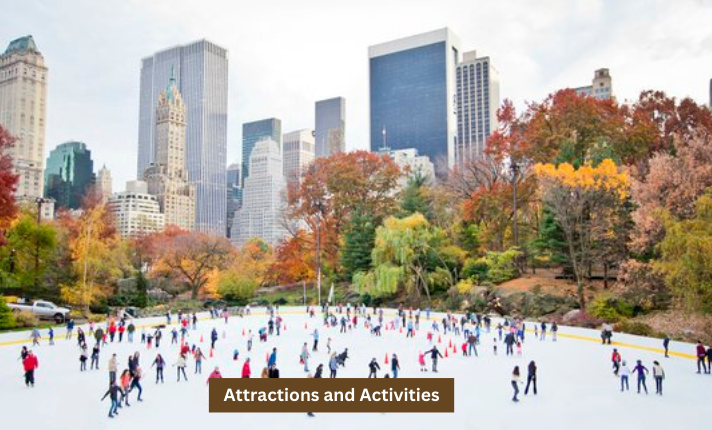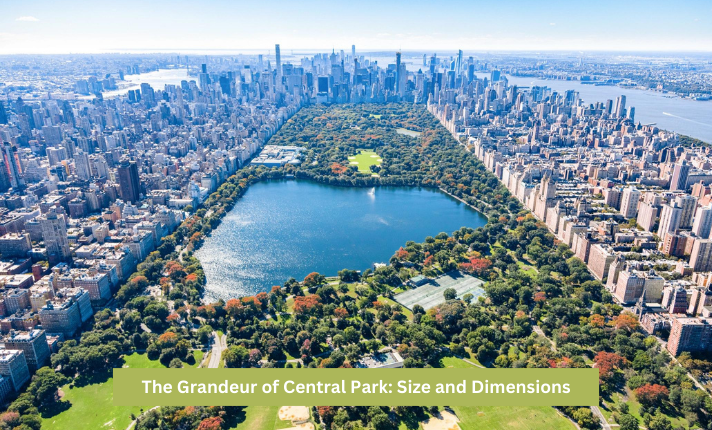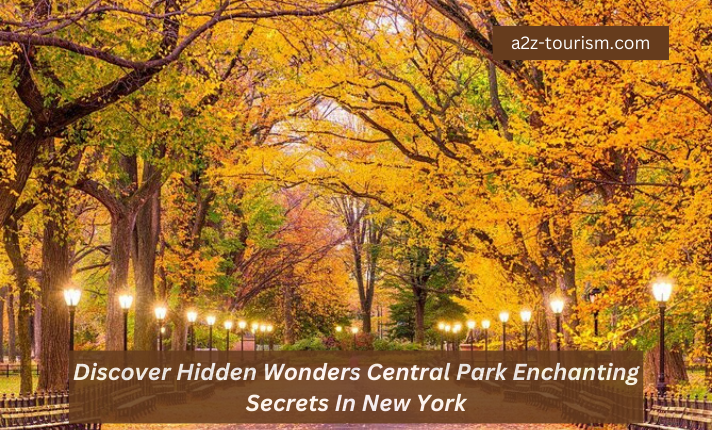Central Park NY, a sprawling oasis amidst the bustling metropolis of New York City, is a landmark destination unlike any other. This verdant escape, meticulously designed by visionary landscape architects, offers a haven for both locals and tourists seeking respite, recreation, and a connection with nature.

A Brief History of Central Park NY
The notion of a large public park in New York City emerged in the mid-19th century as the city’s population boomed and green spaces dwindled. In 1853, the dream became a reality with the establishment of Central Park. Landscape architects Frederick Law Olmsted and Calvert Vaux triumphed in a design competition, and construction commenced on 843 acres of Manhattan real estate.

Discover the History, Attractions, and More
Central Park, located in the heart of Manhattan, New York City, is an urban oasis that seamlessly blends nature with city life. As the first landscaped park in the United States, it has a rich history and offers a diverse range of attractions for both locals and visitors. Let’s explore Central Park’s fascinating story, its dimensions, and what makes it so famous.
History of Central Park
Central Park’s creation began in 1858, driven by the need to provide recreational space for the rapidly growing city. Designed by landscape architects Frederick Law Olmsted and Calvert Vaux, it marked a new era in urban planning. The park’s original purpose was to offer New Yorkers an escape from the stresses of urban life, allowing them to connect with nature.
Dimensions and Layout
- Size: Central Park spans an impressive 843 acres (341 hectares), making it one of the largest urban parks globally. It stretches from 59th Street to 110th Street and from Fifth Avenue to Central Park West.
- Shape: The park is a rectangular expanse, measuring 2.5 miles long and 0.5 miles wide.
- Landmarks: Within its boundaries lie iconic landmarks such as the Central Park Zoo, Belvedere Castle, Strawberry Fields, and Bethesda Terrace.

Attractions and Activities
- The Ramble and Lake: Explore the serene woodlands of the Ramble and enjoy picturesque views of the lake.
- Hallett Nature Sanctuary: A hidden gem for birdwatchers and nature enthusiasts.
- Jacqueline Kennedy Onassis Reservoir: A scenic spot for jogging and contemplation.
- Sheep Meadow: A vast grassy area perfect for sunbathing and picnics.
- Wollman Rink: Ice skating in winter with a backdrop of city skyscrapers.
- Central Park Carousel: A classic carousel ride for all ages.
- Central Park Mall: Stroll along the tree-lined promenade.
- Bethesda Terrace: Admire the grand architecture and views of the lake.

The Grandeur of Central Park: Size and Dimensions
Central Park’s size is truly awe-inspiring. Spanning an impressive 843 acres (341 hectares), it measures 2.5 miles (4 kilometers) long and half a mile (0.8 kilometers) wide. While not the largest park in the world, Central Park’s dimensions allow for an astonishing diversity of landscapes, attractions, and activities.
Is Central Park in Manhattan?
Yes, Central Park is situated entirely within the borough of Manhattan, offering a vital green lung in the heart of the city. This Manhattan location makes it easily accessible from all corners of the island, transforming it into a backyard playground for millions.
Unveiling Central Park’s Splendor: A Map Exploration
A Central Park map reveals a treasure trove of sights and experiences. Visitors can embark on strolls through the meticulously landscaped gardens, rent a rowboat, and explore the serene Lake, or challenge themselves with a hike on the Ramble’s winding paths. Iconic landmarks like Belvedere Castle and Bethesda Fountain offer picturesque backdrops, while Sheep Meadow provides a sprawling green space for picnics, sunbathing, and people-watching.
Delving into Central Park’s Ownership
Central Park is not owned by a private entity, but rather by the City of New York. However, the Central Park Conservancy, a non-profit organization, plays a crucial role in its management and maintenance. Through fundraising and public-private partnerships, the Conservancy ensures the park’s continued vibrancy and beauty.
Unveiling the Emerald Heart of NYC
Delving Deeper into Central Park’s Allure
Central Park’s vastness allows for a remarkable variety of experiences. Here’s a glimpse into some of its hidden gems and lesser-known attractions:
- The Ravine: Nestled between the Great Lawn and Belvedere Castle, The Ravine offers a tranquil escape with cascading waterfalls, lush greenery, and a rustic bridge.
- The Pool: Located near Central Park South, The Pool is a haven for model sailboat enthusiasts. On a sunny day, watching these miniature vessels navigate the water is a delightful pastime.
- The Hallett Nature Sanctuary: This secluded area on the park’s eastern side provides a unique opportunity to experience a native New York forest ecosystem. Birdwatchers and nature enthusiasts will find this spot particularly rewarding.
- The Loch: A picturesque lake located north of the Metropolitan Museum of Art, The Loch offers a peaceful respite amidst the park’s bustling center. Rent a rowboat and explore its tranquil waters for a unique perspective of the park.
- Belvedere Castle: This whimsical Gothic Revival structure perched on a hilltop offers stunning panoramic views of the park’s central area. Explore the castle’s nooks and crannies or simply admire its architectural charm.
Art and Culture in Central Park NY
Central Park is not just a green haven; it’s also a vibrant cultural hub. Several museums and art installations are scattered throughout the park, offering visitors a chance to engage with art and history.
- The Metropolitan Museum of Art: Bordering the park’s eastern edge, The Met is a world-renowned institution housing a vast collection of art spanning centuries. A visit to The Met is a must for any art enthusiast.
- The Frick Collection: Located on the park’s northern border, The Frick Collection showcases Western European art from the 14th to the 19th centuries. The intimate setting and stunning mansion housing the collection make it a unique experience.
- Shakespeare Garden: This delightful spot features plantings mentioned in the works of William Shakespeare. Enjoy a stroll through the fragrant blooms and immerse yourself in the Bard’s world.
- Central Park Conservancy Art Program: Throughout the year, the Central Park Conservancy presents a diverse range of art installations scattered throughout the park. These temporary exhibits add a touch of contemporary flair to the park’s landscape.
Planning Your Visit to Central Park NY
Central Park is a vast space, and planning your visit can help you maximize your experience. Here are some tips:
- Consider the time of year: Spring and fall offer pleasant temperatures and vibrant foliage. Summer can be crowded, but free concerts and Shakespeare in the Park performances add to the lively atmosphere. Winter offers a magical experience with snow-covered landscapes and opportunities for ice skating.
- Choose your entrance wisely: Central Park has numerous entrances. Research attractions you’d like to see and choose an entrance closest to them.
- Explore by theme: Central Park caters to diverse interests. Plan your visit around a specific theme, such as history, art, nature, or family-friendly activities. The Central Park Conservancy website offers themed itineraries to help you plan.
- Utilize rental options: Rent bikes for a scenic ride, rowboats to explore the Lake, or pedicabs for a leisurely tour.
- Pack essentials: Wear comfortable shoes, bring sunscreen and water, and pack a picnic basket if you plan to dine outdoors. Don’t forget insect repellent, especially during the summer months.
Conclusion:
Central Park NY stands as a testament to the power of urban green spaces. It serves as a sanctuary for millions, offering a refuge from the city’s hustle and bustle while fostering a deep connection with nature. Whether you seek relaxation, recreation, or cultural experiences, Central Park has something for everyone. So, pack your walking shoes, embrace the emerald heart of NYC, and create lasting memories in this iconic park.
FAQs
Why is Central Park New York so famous?
Central Park’s fame stems from its unique ability to blend nature and urban life. It provides a vital escape for city dwellers, offering a refuge for relaxation, recreation, and cultural events. The park’s rich history, stunning design, and diverse offerings contribute to its enduring popularity.
What is Central Park popular for?
Central Park caters to a wide range of interests. Visitors can enjoy:
- Relaxation: Picnics, sunbathing, and peaceful walks.
- Recreation: Biking, boating, and exploring the park’s many playgrounds.
- Culture: Free concerts, art installations, and historical landmarks.
- Nature: Exploring the Ramble’s woodland trails or the serene beauty of the Lake.
Is Central Park one of the biggest parks in the world?
While not the biggest park globally, Central Park’s size is significant, especially considering its Manhattan location. Its vastness allows for a remarkable diversity of landscapes and activities.
Is Central Park NYC free?
Central Park is free to enter and explore. However, some activities within the park, such as renting a rowboat or participating in guided tours, may incur fees.
Can you live in Central Park?
Central Park is not designated as a residential area. However, there are residences bordering the park, offering stunning views and a unique connection to this urban oasis.
What is the most expensive part of Central Park?
Central Park does not have designated “expensive” areas. However, the property surrounding the park, particularly along Fifth Avenue, commands some of the highest real estate prices in New York City.

